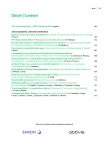History and presence of hepatitis B and C therapy
Authors:
Petr Husa Sr
Authors‘ workplace:
Klinika infekčních chorob LF MU a FN Brno, pracoviště Bohunice
Published in:
Vnitř Lék 2017; 63(7-8): 465-470
Category:
Reviews
Overview
Infection with hepatitis B virus (HBV) and hepatitis C virus (HCV) are the world’s major causes of chronic liver disease. Care of patients infected with HBV and HCV and/or over the last 20 years has significantly improved thanks to the better understanding of the pathophysiology of disease, improvement of diagnostic, therapeutic and preventive options. The goal of treatment of chronic hepatitis B is to extend the length of life and improve its quality through the barriers of the progression of chronic hepatitis to cirrhosis, decompensation cirrhosis and hepatocellular carcinoma (HCC). Chronic HBV infection can by currently treated either with tenofovir or entecavir orally (absolute majority of cases), and that in the long-term (years), or even for life-long therapy, or with pegylated interferon α-2a, which is given by injection once a week for 48 weeks (limited possibility of use). The primary goal of chronic hepatitis C treatment is to cure the infection, by achieving a sustained virological response defined as undetectable virus nucleic acid (HCV RNA) in peripheral blood 12 or 24 weeks after the end of therapy. At present, IFN-free regimens become the standard of chronic HCV therapy with the efficiency of 95–100 % and with minimum of side effects and contraindications.
Key words:
chronic hepatitis B – chronic hepatitis C – IFN-free therapy
Sources
1. World Health Organization. Guidelines for the screening, care and treatment of persons with chronic hepatitis C infection. Updated version April 2016. Dostupné z WWW: <http://www.who.int/hiv/topics/hepatitis/en>.
2. European Association for the Study of the Liver. EASL Clinical Practice Guidelines: Management of chronic hepatitis B. J Hepatol 2012; 57(1): 167–185. Dostupné z DOI: <http://dx.doi.org/10.1016/j.jhep.2012.02.010>.
3. Brouwer WP. Tenofovir alafenamide for hepatitis B: evolution or revolution? Lancet Gastroenterol Hepatol 2016;1(3):174–175. Dostupné z DOI: <http://dx.doi.org/10.1016/S2468–1253(16)30083–8>. Dostupné z WWW: <http://www.thelancet.com/gastrohep>.
4. European Association for the Study of Liver. EASL recommendations on treatment of hepatitis C 2015. Summary. Dostupné z WWW: <http://www.easl.eu/medias/cpg/HCV2016/Summary.pdf> [3.3.3017].
5. AASLD recommendation for testing, managing, and treating hepatitis C. Dostupné z WWW: <http://www.hcvguidelines.org>. [3.3.2017].
6. Foster GR et al. Sofosbuvir and velpatasvir for HCV genotype 2 and 3. N Engl J Med 2015; 373(27): 2608–2617. Dostupné z DOI: <http://dx.doi.org/10.1056/NEJMoa1512612>.
7. Pawlotsky JM. Hepatitis C virus resistance to Direct-Acting Antiviral drugs in interferon-free regimens. Gastroenterology 2016; 151(1): 70–86. Dostupné z DOI: <http://dx.doi.org/10.1053/j.gastro.2016.04.003>.
8. University of Liverpool. Drug interactions charts. Dostupné z WWW: <http://www.hep-druginteractions.org>.
9. HARVONI. Souhrn údajů o přípravku. Dostupné z WWW: <http://www.ema.europa.eu/docs/cs_CZ/document_library/EPAR_-_Product_Information/human/003850/WC500177995.pdf>. [15.8.2016].
10. SOVALDI. Souhrn údajů o přípravku. Dostupné z WWW: <http://www.ema.europa.eu/docs/cs_CZ/document_library/EPAR_-_Product_Information/human/002798/WC500160597.pdf>. [15.8.2016].
11. EPCLUSA. Souhrn údajů o přípravku. Dostupné z WWW: <http://www.ema.europa.eu/docs/cs_CZ/document_library/EPAR_-_Product_Information/human/004210/WC500211151.pdf>. [15.8.2016].
12. VIEKIRAX. Souhrn údajů o přípravku. Dostupné z WWW: <http://www.ema.europa.eu/docs/cs_CZ/document_library/EPAR_-_Product_Information/human/003839/WC500183997.pdf>. [15.8.2016].
13. EXVIERA. Souhrn údajů o přípravku. Dostupné z WWW: <http://www.ema.europa.eu/docs/cs_CZ/document_library/EPAR_-_Product_Information/human/003837/WC500182233.pdf>. [15.8.2016].
14. Urbánek P. Exviera, Viekirax. Gastroent Hepatol 2015; 69(1): 75–80. Dostupné z DOI: <http://dx.doi.org/10.14735/amgh201575>.
15. ZEPATIER. Souhrn údajů o přípravku. Dostupné z WWW: <http://www.ema.europa.eu/docs/cs_CZ/document_library/EPAR_-_Product_Information/human/004126/WC500211235.pdf>. [15.8.2016].
16. Bourliére M, Gordon SC, Ramji A et al. Sofosbuvir/velpatasvir/voxilaprevir for 12 weeks as a salvage regimen in NS5A inhibitor-experienced patients with genotype 1–6 infection: The phase 3 POLARIS-1 study. Hepatology 2016; 63(Suppl 1): 102A-103A.
17. Jacobsson IM, Asselah T, Nahass R et al. A randomized phase 3 trial of sofosbuvir/velpatasvir/voxilaprevir for 8 weeks compared to sofosbuvir/velpatasvir for 12 weeks in DAA-naïve genotype 1–6 HCV infected patients: The POLARIS-2 study. 67th Annual meeting of AASLD, Boston, 11.-15.11. 2016. Dostupné z WWW: <http://www.natap.org/2016/AASLD/AASLD_33.htm>.
18. Foster GR, Thompson A, Ruane PJ et al. A randomized, phase 3 trial of sofosbuvir/velpatasvir/voxilaprevir for 8 weeks and sofosbuvir/velpatasvir for 12 weeks for patients with genotype 3 HCV infection and cirrhosis: The POLARIS-3 study. Hepatology 2016; 63(Suppl 1): 135A-136A.
19. Zeuzem S, Flamm SL, Tong M et al. A randomized, controlled, phase 3 trial of sofosbuvir/velpatasvir/voxilaprevir for 8 weeks and sofosbuvir/velpatasvir for 12 weeks in Direct-Acting Antiviral-experienced patients with genotype 1–6 HCV infection: The POLARIS-4 study. Hepatology 2016; 63(Suppl 1): 56A. Dostupné z WWW: <http://www.natap.org/2016/AASLD/AASLD_18.htm>.
20. Zeuzem S, Feld JJ, Wang S et al. ENDURANCE-1: Efficacy and safety of 8-versus 12-week treatment with ABT-493/ABT-530 in patient with chronic HCV genotype 1 infection. Hepatology 2016; 63(Suppl 1): 132A-133A. Dostupné z WWW: <http://dx.doi.org/http://www.natap.org/2016/AASLD/AASLD_32.htm>.
21. Kowdley KV, Colombo M, Zadeikis N et al. ENDURANCE-2: Safety and efficacy of ABT-493/ABT-530 in hepatitis C virus genotype 2–infected patients without cirrhosis, a randomized, double-blind, placebo-controlled study. Hepatology 2016; 63(Suppl 1): 39A. Dostupné z WWW: <http://www.natap.org/2016/AASLD/AASLD_14.htm>.
22. Asselah T, Hezode C, Zadeikis N et al. ENDURANCE-4: Efficacy and safety of ABT-493/ABT-530 treatment in patients with chronic HCV genotype 4, 5, or 6 infection. Hepatology 2016; 63(Suppl 1): 63A.
23. Wyles DL, Poordad F, Wang S et al. SURVEYOR-II, Part 3: Efficacy and safety of ABT-493/ABT-530 in patients with hepatitis C virus genotype 3 infection with prior treatment experience and/or cirrhosis. Hepatology 2016; 63(Suppl 1): 62A-63A. Dostupné z WWW: <http://www.natap.org/2016/AASLD/AASLD_20.htm>.
Labels
Diabetology Endocrinology Internal medicineArticle was published in
Internal Medicine

2017 Issue 7-8
Most read in this issue
- Nosocomial pneumonia
- PCR diagnosis of infectious diseases
- The current problems related to nosocomial infections and antibiotic resistance today
- Community pneumonia – fundamentals of diagnosing and treatment
